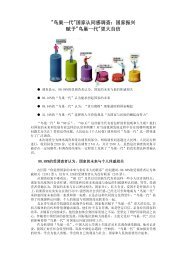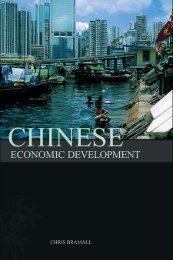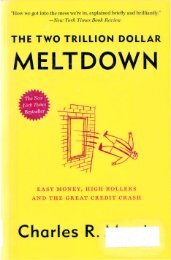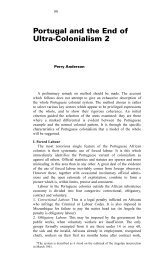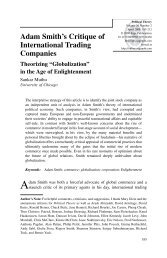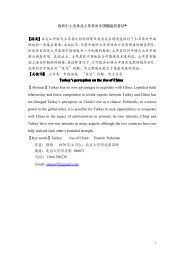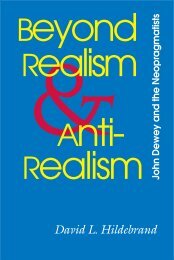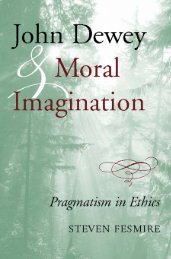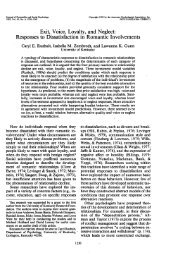Battle for China's Past : Mao and the Cultural Revolution
Battle for China's Past : Mao and the Cultural Revolution
Battle for China's Past : Mao and the Cultural Revolution
You also want an ePaper? Increase the reach of your titles
YUMPU automatically turns print PDFs into web optimized ePapers that Google loves.
DEBATING THE CULTURAL REVOLUTION<br />
troupes saw a drop in <strong>the</strong>ir numbers during <strong>the</strong> <strong>Cultural</strong> <strong>Revolution</strong>,<br />
from 3,458 in 1965 to 2,906 in 1976. But <strong>the</strong>se figures do not include <strong>the</strong><br />
unregistered unofficial <strong>the</strong>atre troupes that were created <strong>and</strong> active in<br />
rural China, like <strong>the</strong> one I experienced in Gao Village.<br />
More importantly, educated youth <strong>and</strong> many o<strong>the</strong>r Chinese read<br />
many literary works that <strong>the</strong>y were not supposed to read, such as works<br />
by Russian writers, revolutionary or o<strong>the</strong>rwise (Wang Jianzhao 2002).<br />
They not only read extensively but <strong>the</strong>y also created <strong>the</strong>ir own literature.<br />
Artists like Mang Ke <strong>and</strong> Duo Duo, both now known in <strong>the</strong> West, wrote<br />
<strong>and</strong> worked creatively during <strong>the</strong> <strong>Cultural</strong> <strong>Revolution</strong>. O<strong>the</strong>rs include<br />
Bei Dao, Yan Li, Yan Xiaoqing, Peng Gang, Shi Baojia <strong>and</strong> Yue Zhong.<br />
Ano<strong>the</strong>r example of collective creativity is <strong>the</strong> Han Ying cidian<br />
(Chinese–English Dictionary) compiled by a group of academics who<br />
worked collectively at <strong>the</strong> Beijing Foreign Language Institute <strong>for</strong> ten<br />
years. First published in 1978, <strong>the</strong> dictionary, in my opinion, remains <strong>the</strong><br />
best of its kind inside or outside China, past or present.<br />
The objects on display at <strong>the</strong> exhibition in Seattle are evidence that<br />
<strong>the</strong>re was an upsurge of creativity among <strong>the</strong> popular masses during<br />
<strong>the</strong> <strong>Cultural</strong> <strong>Revolution</strong>. The chopsticks holder, <strong>for</strong> instance, is a beautiful<br />
piece of art. It is itself made of chopsticks <strong>and</strong> reflects <strong>the</strong><br />
tremendous resourcefulness of <strong>the</strong> labouring Chinese. It is cheap to<br />
make <strong>and</strong> it is practical. Moreover, it cleverly combines <strong>the</strong> content<br />
(chopsticks holder) with <strong>the</strong> <strong>for</strong>m (chopsticks). If we treasure art <strong>and</strong><br />
artefacts that have been inspired by religions – institutions with brutal<br />
<strong>and</strong> murderous records – <strong>and</strong> if we value modern artefacts that are<br />
driven by commercialism, <strong>the</strong>n I do not see why we should denigrate<br />
<strong>the</strong> value of art from <strong>the</strong> Chinese <strong>Cultural</strong> <strong>Revolution</strong> just because it<br />
came out of a political movement. Culture is not an abstract entity. It is<br />
lived experience <strong>and</strong> creative activities. By living <strong>the</strong>ir ordinary lives<br />
<strong>the</strong> ordinary Chinese may continue practising what has been passed<br />
on, but <strong>the</strong>y may also cut ties with <strong>the</strong>ir past. They may want to set up<br />
new practices <strong>for</strong> <strong>the</strong>ir future. In <strong>the</strong> midst of all <strong>the</strong> change <strong>and</strong> continuity,<br />
culture was destroyed <strong>and</strong> culture was created, as <strong>the</strong> displays<br />
in <strong>the</strong> Burke Museum exhibition show.<br />
If we accept <strong>the</strong> truth that <strong>the</strong> <strong>Cultural</strong> <strong>Revolution</strong> was ten years of<br />
catastrophe, <strong>the</strong>n <strong>the</strong>re is no room <strong>for</strong> voices that differ from those of<br />
<strong>the</strong> Chinese authorities <strong>and</strong> <strong>the</strong> Chinese elite intelligentsia who<br />
condemn <strong>the</strong> <strong>Cultural</strong> <strong>Revolution</strong> <strong>and</strong> who exploit <strong>the</strong> holocaust<br />
discourse (Sahlins 1985) to construct <strong>the</strong> <strong>Cultural</strong> <strong>Revolution</strong> history.<br />
The best example of how <strong>the</strong> <strong>Cultural</strong> <strong>Revolution</strong> history is<br />
constructed can be seen how <strong>the</strong> <strong>Cultural</strong> <strong>Revolution</strong> is ‘remembered’.<br />
As it is true in <strong>the</strong> case of o<strong>the</strong>r histories, <strong>the</strong> history of <strong>the</strong> <strong>Cultural</strong><br />
<strong>Revolution</strong> is ‘in its telling’ (Taussig 1989). But who is doing <strong>the</strong><br />
telling? Who remembers what? Who is allowed to voice her/his<br />
[ 29 ]





